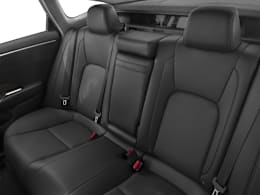The Honda Clarity family of cars showcases Honda’s diverse alternative fuel technologies. One version is a hydrogen-powered fuel-cell car, another is a pure electric vehicle (EV), and the third is a plug-in hybrid, which is the version that is viable for most drivers.
The plug-in hybrid Clarity competes with the Chevrolet Volt and Toyota Prius Prime. It can operate just on electric power for a limited distance, and when the battery charge runs out, it starts up its gas engine. It works as promised, but the Clarity suffers from some annoying Honda quirks, such as confusing controls and fussy gear selector. In addition, the gas engine is loud when it kicks in.
We went 48 miles on electric-only driving, which gives the Clarity one of the longest ranges for plug-in hybrids that we’ve seen. It is better than the Prius Prime and almost matches the Chevrolet Volt.
The Clarity remained in electric mode even when drivers went up hills, merged, or had to use a heavy foot for passing. The engine kicks in to deliver full power when the accelerator pedal is pushed towards the end of its travel, past what Honda calls the click point.
Once the battery is depleted and the Clarity switches to gas-engine power, we got 39 mpg overall in our tests. The seven-gallon gas tank gives the Clarity an additional 270 miles of range, which eliminates range anxiety. But its combined range of roughly 300 miles is mediocre.
The transition from electric to gas operation is seamless. But if the driver punches the accelerator, or when the car switches to hybrid mode because the battery has been depleted, the four-cylinder engine makes a loud ruckus.
It takes almost 2.5 hours to recharge the Clarity through a 240-volt connector, and takes 12 hours to charge it on a 120-volt household outlet. This makes it possible to charge it overnight, and avoid investing in a 240-volt connector.
We found that the handling is awkward because the body leans in corners and steering response is sluggish. On the other hand, ride comfort is the Clarity’s strong suit; its suspension effectively absorbs ruts and bumps. The cabin is quiet and almost silent when driving on electric power, but the engine groans when running.
The Clarity has much more interior room than the Prius and Volt, particularly in the rear seat, and it is also easier to get in and out of. However, the front seat has a too-short bottom cushion, limited range of adjustments, and lacks lower-back support.
The cabin is nicely finished with grained wood trim. The Touring version adds power-operated leather seats and a navigation system. The trunk has decent room and features a tiny pass through to the cabin. One big benefit is that there isn’t any intrusion from the battery pack; however, the trunk opening is on the small side.
An eight-inch touch-screen infotainment system is standard, but it is an older Honda system that’s slow to respond to inputs, fussy to use, and lacks knobs or hard buttons. The Clarity uses Honda’s frustrating gear selector, which consists of a row of push/pull buttons that are cumbersome to use. It is an overly-complex process to work the onboard computer through steering wheel controls, particularly because it’s hard to differentiate the audio controls from those for the multi-info display.
The Clarity comes standard with the Honda Sensing suite of advanced safety features, which consists of forward-collision warning, automatic emergency braking, lane-departure warning, and lane-keeping assist. But blind-spot warning is not available; instead, Honda uses its older LaneWatch system. This is a video feed showing a rearward view along the passenger side of the car, which is activated when the driver indicates a right turn with the turn-signal stalk,. We find this system distracting, particularly because it takes over the whole infotainment screen, and it isn’t a substitute for a true blind-spot detection system.


























